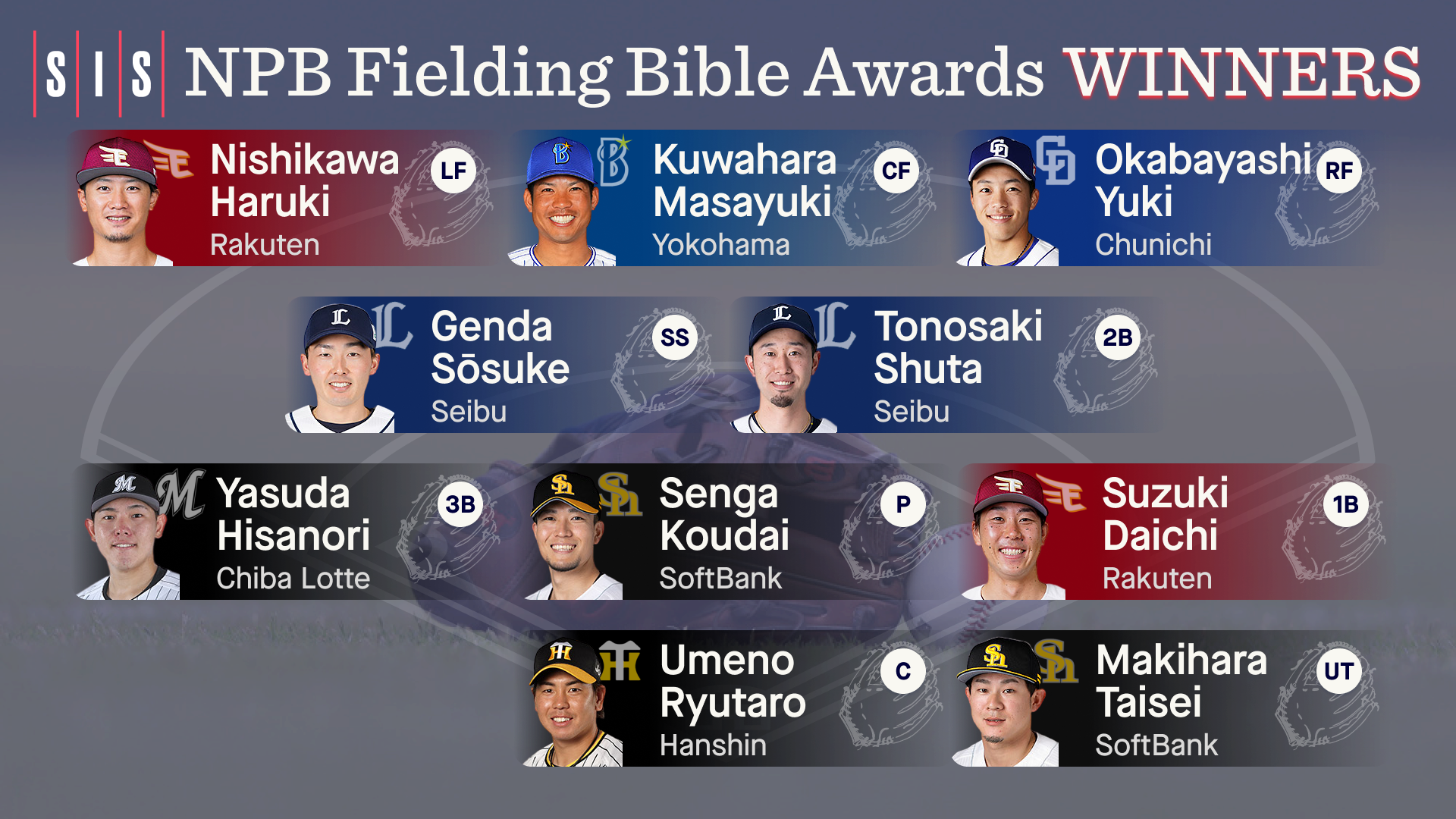By TED BAARDA
Reports have surfaced recently that NPB’s Hiroshima Carp will be posting their star right fielder, Seiya Suzuki, in the coming offseason. Suzuki is coming off a monster season with the Carp, as he led Japan’s Central League in all three triple-slash categories with a batting line of .317/.433/.639, and set a career high with 38 home runs.
Predicting how that success will translate to MLB performance can be tricky, however. Adjusting for the quality of competition faced is one aspect, but there are also the challenges of moving to a new country and culture, as well as adapting to a new role on a new team that can have an effect on the player’s performance. There is also an argument that certain skill sets are more transferable than others when players move to MLB.
In order to get a ballpark idea of what to expect from Seiya Suzuki, I am going to compare his last two seasons in NPB to another recent corner outfielder from the same league, Yoshi Tsutsugo. I chose Tsutsugo because he plays a similar position, was close to the same age when posted, and made the transition recently.
Tsutsugo was known as a power hitter in Japan, and particularly a home run hitter. He had some swing-and-miss in his game, but made up for it by hitting the ball hard when he did make contact and drawing walks as pitchers worked around his power. Here are his numbers from his last two years in Japan, and his combined line in MLB:
| Season | League | AVG | OBP | SLG | K% | BB% |
| 2018 | NPB | .295 | .393 | .596 | 18% | 14% |
| 2019 | NPB | .272 | .388 | .511 | 25% | 16% |
| 2020-2021 | MLB | .209 | .309 | .388 | 27% | 12% |
Tsutsugo had a down year in 2019 before he came to MLB, with a .85-point drop in slugging percentage and an increase of 7 percentage points to his strikeout rate. Facing MLB pitching, his numbers further dipped, showing how good MLB pitchers are.
Tsutsugo struggled to catch up to fastballs at the beginning of his MLB career, which makes sense since far fewer pitchers in NPB routinely throw 95 MPH or higher. However, he did finish his 2021 season off strong with the Pirates, hitting .268/.347/.535 in 144 plate appearances over 43 games. With Pittsburgh, he was also able to get more regular playing time than he did with the contending Rays and Dodgers.
For comparison, here are Seiya Suzuki’s numbers over his last two seasons in NPB:
| Season | League | AVG | OBP | SLG | K% | BB% |
| 2020 | NPB | .300 | .409 | .544 | 14% | 14% |
| 2021 | NPB | .317 | .433 | .639 | 17% | 16% |
The high batting averages for Suzuki are no fluke, as this is his sixth consecutive season with an average over .300. He has a fairly flat bat path which produces lots of line drives when he squares up the ball, allowing for higher averages than the fly ball approach of Tsutsugo.
Suzuki’s athleticism, a key differentiator between him and Tsutsugo, shows in his batting stance.
He incorporates a leg kick, lifting his front leg as the pitcher delivers home and balancing with one foot in the air for a second before stepping into his swing and driving his bat towards the ball. He has a selective approach at the plate, taking pitches until he gets the one he wants.
With two strikes he loses the leg kick to sacrifice a little power in order to make contact and keep at bats alive.
Suzuki is coming off a career year in the power department, smashing his previous high of 30 HR with his 38 this season. This also led to a career best slugging percentage of .639, his third season slugging .600 or higher. For comparison’s sake, Tsutsugo only had one season over .600, with a .680 SLG in 2016.
Offensively, Suzuki has a clear edge over Tsutsugo before coming over to MLB. His career marks in all three triple slash stats beat Tsutsugo’s handily and, if he is posted this off-season, Suzuki will also be coming off a much better platform year than Tsutsugo.
In other areas of their games, Suzuki also tends to outshine Tsutsugo. Defensively Tsutsugo is more or less a liability. He played a lot of left field in Japan due to the Central League not utilizing a DH, and per DRS he was a negative fielder in both 2018 and 2019:
| Season | Position | Innings | DRS |
| 2018 | LF | 1105 | -9 |
| 2019 | LF | 840 | -6 |
| 2019 | 3B | 230 | -8 |
Tsutsugo does not have a large enough sample at any position in MLB to make any conclusive judgements from, but he does have 180 innings of +2 DRS fielding in left in MLB, along with -2 in 89 innings at third. He also has played some first base and right field in MLB, scoring below average at both positions.
One thing that stands out is that Tsutsugo struggled mightily in both 2018 and 2019 in left field with deep balls. This may not be entirely his fault however, as NPB teams will play their outfielders much shallower than MLB teams at times, giving up the deep ball in the hopes of taking away some singles in front of outfielders.
Since balls over a fielder’s head are worth more runs than the shallow hits, this positioning can adversely affect an outfielder’s DRS, and might explain why DRS is more of a fan of his work in MLB than in NPB.
For comparison, here is Seiya Suzuki’s Defensive Runs Saved over his last two seasons:
| Season | Position | Innings | DRS |
| 2020 | RF | 1015 | 6 |
| 2021 | RF | 1037 | 2 |
Suzuki’s big skill on defense is his arm, and most of his value in the outfield comes from throwing out runners, or preventing them from advancing. He came up as a pitcher and infielder, so his outfield defense was a work in progress earlier in his career, though he has improved at tracking balls down. For the same reason that Tsutsugo’s defense grades out better in MLB, there is a possibility that Suzuki’s defense could play better in MLB as well.
Playing in right field, where the throw to third base is longer and therefore more challenging, Suzuki has kept runners from advancing extra bases at roughly the same rate that Tsutsugo did from left field, even though Tsutsugo had the advantage of a much shorter throw to third.
Suzuki also has 12 unaided assists in the last two seasons (assists where the outfielder directly throws out a runner), compared to Tsutsugo’s five over his last two seasons in NPB.
In terms of baserunning, while Suzuki is more athletic than Tsutsugo, he doesn’t necessarily have as refined baserunning instincts. For their NPB careers, Suzuki is 82-for-134 stealing bases (61% success rate), while Tsutsugo was 5-for-9. I expect Suzuki to be given less free reign to attempt stolen bases in MLB, though his good speed will still be a benefit on the basepaths allowing him to take extra bases on balls in play.
Two years ago Yoshi Tsutsugo was an intriguing player, and after his run in Pittsburgh to end the 2021 season he still is. However, Seiya Suzuki looks to have a higher chance to be an impact talent and can impact a game in multiple ways. We could see that on display as soon as Opening Day.



